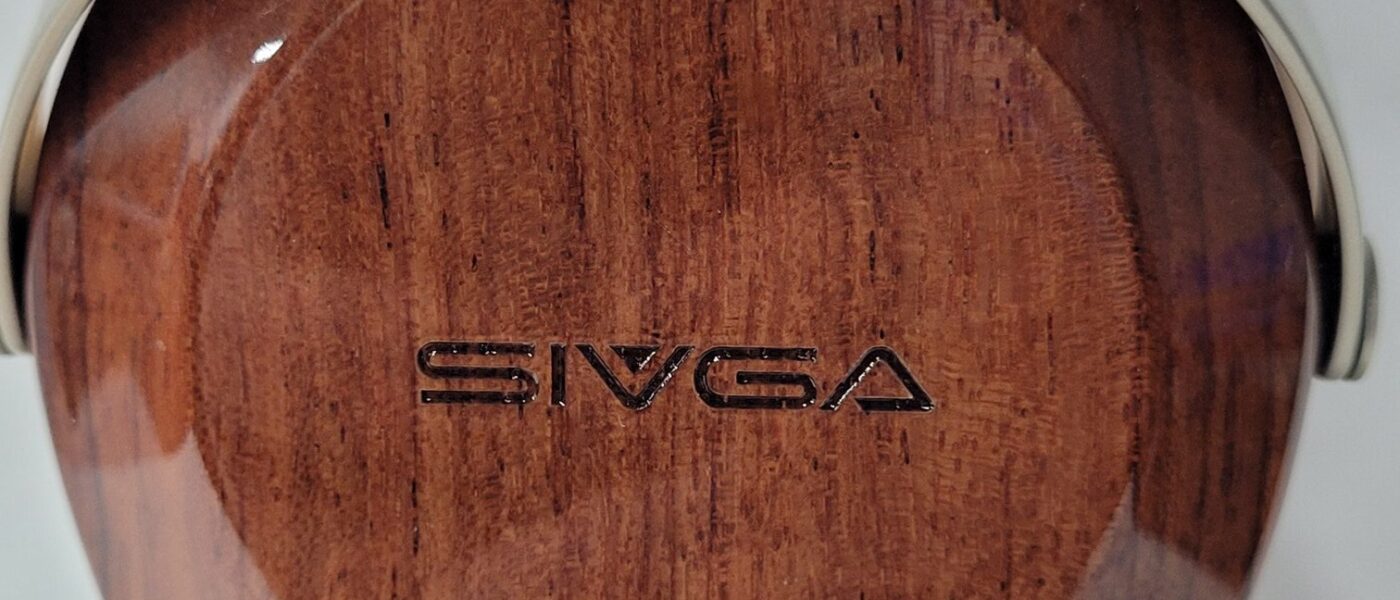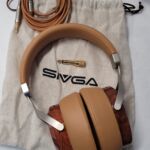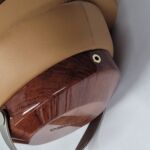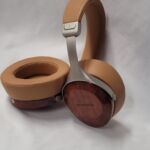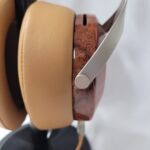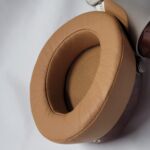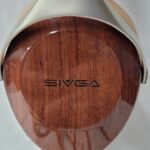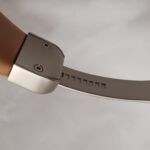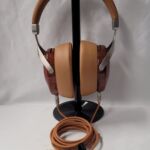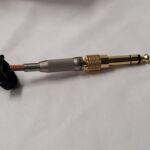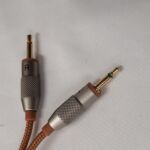Sivga SV021 Robin
disclaimer: The Sivga SV021 Robin was sent to me directly by Sivga for review. Sivga and its sibling Sendy Audio are making in-roads into the US market and are carried by Audio46 and Musicteck in the US as well as being available for order directly from the Sivga website worldwide. I have no financial interest in Sivga, Sendy, or any of their distributors, nor have I received any compensation for this review. Be sure to follow Sivga on Facebook if you haven’t already so you get the next generation of product announcements.
Unboxing / Packaging:
The Robin comes in a black lift top box with a silver line drawing of the headphones on the front and the specs and company info on rear. Lifting the lid reveals the headphones in a foam surround with the cable, carry bag, and 6.35mm adapter housed in a separate compartment in the foam to keep the headphones from getting scratched in transit. The bag is a linen like material but is thin enough that it may not protect the headphones well during travels. The cable is cloth wrapped and uses 2.5mm connectors at the northern ends and a 3.5mm single ended connector at the southern end.
Build/Fit:
Construction on the Robin is quite good for the price but there is some dichotomy as the cups are well finished wood and the pads and headband sport a leather-like feel with memory foam where it is needed. The headband for example has a soft high lift foam on the under-side where it contacts the head and a thinner stiffer foam on the upper band where it does not. Metal parts have a brushed finish and are largely stamped parts. The gimbals do have very positive click adjustments with good range but have no rotation on the vertical axis as they have no hinge to allow it. Horizontal rotation is roughly 30º. I had no issues with fit but some with glasses may. The wooden cups have Sivga printed on the outside and 2.5mm ports at the bottom-most point. Pads are removable by twisting which reveals a plastic baffle inset into the cup. Replacement pads are available directly from Sivga should the need for replacement arise. There are two colors available, the one shown here in brown,tan and silver and another blacked out model with dark wood, black pads and headband and darker metal fittings and gimbals.
Internals:
The Robin uses a 50mm dynamic driver using a polycarbonate and fiber diaphragm and in-house designed magnetic structure that uses neodymium, iron and boron to improve performance. The voice-coil is made of Copper-clad aluminum wire to further improve performance. Nominal impedance is listed as 32Ω with a sensitivity of 105dB/mW which makes them quite easy to drive and I found they worked well with the Xduoo Link 2 dongle, the Cayin N3 Pro, and the Yulong Aurora. The Robin does benefit from more potent sources by gaining a bit more headroom with lower powered sources losing available volume control comparatively.
Cable:
The cable provided with the Robin is cloth covered and color matched to the headphone. Hardware is a straight 3.5mm jack at the lower end with a knurled metal housing and a spring style strain relief before exiting as a single strand. The splitter is a matched to the jack housing as are the upper jack housings. Upper jacks are 2.5mm mono style jacks. The upper jacks are marked L and R on the housings and the headphone has matching designations on the metal tips of the headband. The cable itself is single crystal copper.
Sound:
Bass:
Sub-bass presence is good but not emphasized with good extension well into the 20Hz range and enough rumble to make itself known when called for. The Robin won’t jar you with the lows, but does deliver some punch in the lower registers. Mid-bass is a bit thicker and punchier than the sub-bass with a little more emphasis but still not so much as to become boomy or particularly bass forward. Control is good with solid textures and detail in the lows without getting overly thick, bleeding, or obstructing the lower-mids. Not a bass-head model for sure, but good balance of lows vs upper frequencies and a touch of warmth that gives lower mids a bit more note weight.
Mids:
Lower-mids follow the slope of the mid-bass and slowly step back as you move into the true midrange. This gives lower vocals good weight and timbre is quite good. Guitar growl has nice sharp edge to it and the quick decay of the driver helps bring out the rasp. The true mids sit just a touch behind either side with strings having good tone but lacking a touch of energy needed to sound perfect. Piano has a good timbre as well throughout most of its range without sounding too dull. Upper-mids do climb forward which gives them a bit sharper tone than the lower voices and makes higher vocals step forward in the mix. I did hear a few somewhat nasal vocals that needed a bit of EQ to step back that upper-mid/lower-treble slightly to make the Robin a bit more balanced and closer to neutral.
Treble:
Treble starts off by continuing the climb of the upper-mids and gives the Robin a bit of a V shape helping balance the elevation of the mid-bass but also can overshadow even that lower emphasis at times. If the upper-mids were a mild push, the treble is more of a shove. Lots of energy and detail here, but with it is the tendency to become a bit fatiguing during longer listening sessions without a bit of judicious EQ (Thankfully it responds fairly well). The upside is those who have found other models in the price range lacking in treble response now have a new champion as the Robin has no lack of treble energy and snare rattle, percussion snap, and cymbals are all given enough energy to sound more natural than some of those same models. There is air here but it still is a bit limited and sparkle can turn to sizzle on tracks that are mastered on the hot side anyway. I very much like the tuning as far too many offerings of late have gone with a more polite treble and the more assertive nature of the Robin brings out more of the nuance of the music.
Soundstage / Imaging:
For a closed back, the Robin does quite well in stage dimensions and was better than I had anticipated. There is a wide stage with moderate depth and a good sense of height in the mix. Seating the orchestra is straight forward with no big overlaps or spaces and instrument separation aids in that as well as the stage size. Movements are easily tracked around the space and fairly tightly defined and spatial cues are easy to interpret. I did find some mild compression in the lows as tracks got busier but not enough to distract or get muddy until into some pretty crazy stuff.
Thoughts / Conclusion:
With the Robin currently on sale for $149 on Amazon, it would be a good pickup for many looking for a good sounding, good looking headphone without breaking the bank in the process and was honestly better than I expected at the price and better than quite a few bigger name competitors around the price as well. I’d give the Robin serious consideration before looking the ATH-m50, Sony 7506, Blon BL30, or Sennheiser 598 as it combines better build quality than all but the Blon with sound that is more impressive than any of the lot. The signature is more balanced and dynamic with an unabashed treble that helps make sure all the detail and nuance are on full display where these same things are sometimes lost in favor of a more polite treble. In the overall, the Robin won’t likely please the bass-head crowd, nor will the treble shy find it particularly lovable, but for a lot of us in the middle ground, its one of the best $150 headphones available right now.
-
Bass - 7.5/107.5/10
-
Mids - 7/107/10
-
Treble - 7/107/10
-
Soundstage - 6.5/106.5/10
-
Imaging - 7/107/10
Summary
Pros: good build, mild v with good balance, better transparency and detail than anticipated at price
Cons: minimal kit, hot treble at times

